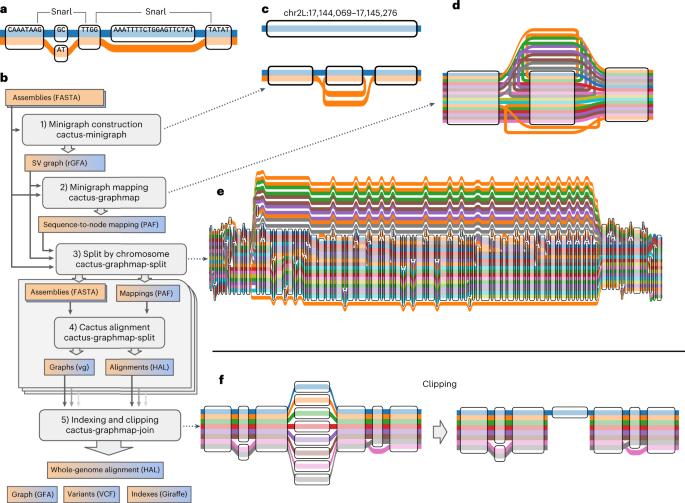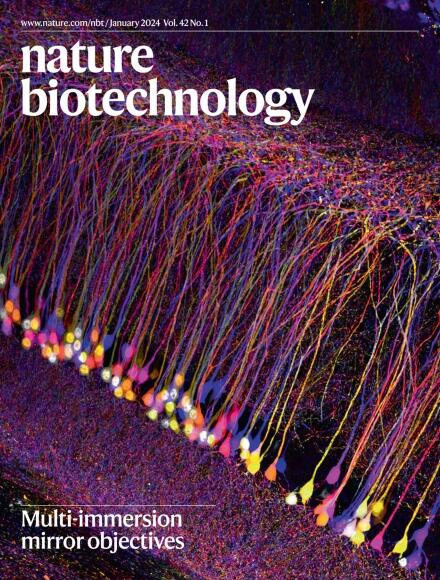Pangenome graph construction from genome alignments with Minigraph-Cactus
IF 41.7
1区 生物学
Q1 BIOTECHNOLOGY & APPLIED MICROBIOLOGY
引用次数: 0
Abstract
Pangenome references address biases of reference genomes by storing a representative set of diverse haplotypes and their alignment, usually as a graph. Alternate alleles determined by variant callers can be used to construct pangenome graphs, but advances in long-read sequencing are leading to widely available, high-quality phased assemblies. Constructing a pangenome graph directly from assemblies, as opposed to variant calls, leverages the graph’s ability to represent variation at different scales. Here we present the Minigraph-Cactus pangenome pipeline, which creates pangenomes directly from whole-genome alignments, and demonstrate its ability to scale to 90 human haplotypes from the Human Pangenome Reference Consortium. The method builds graphs containing all forms of genetic variation while allowing use of current mapping and genotyping tools. We measure the effect of the quality and completeness of reference genomes used for analysis within the pangenomes and show that using the CHM13 reference from the Telomere-to-Telomere Consortium improves the accuracy of our methods. We also demonstrate construction of a Drosophila melanogaster pangenome. Constructing genome graphs directly from genome assemblies overcomes single-reference bias.

利用Minigraph-Cactus基因组比对构建泛基因组图谱。
泛基因组参考通过存储一组具有代表性的不同单倍型及其比对来解决参考基因组的偏差,通常以图表的形式。由变异调用者确定的替代等位基因可用于构建泛基因组图,但长读测序的进步正在导致广泛可用的高质量相控组装。与变体调用相反,直接从程序集构建泛基因组图,可以利用图在不同尺度上表示变异的能力。在这里,我们展示了Minigraph-Cactus泛基因组管道,它直接从全基因组比对中创建泛基因组,并证明了它能够扩展到来自人类泛基因组参考联盟的90个人类单倍型。该方法构建包含所有形式的遗传变异的图形,同时允许使用当前的制图和基因分型工具。我们测量了用于泛基因组分析的参考基因组的质量和完整性的影响,并表明使用来自端粒-端粒联盟的CHM13参考提高了我们方法的准确性。我们还展示了黑腹果蝇泛基因组的构建。
本文章由计算机程序翻译,如有差异,请以英文原文为准。
求助全文
约1分钟内获得全文
求助全文
来源期刊

Nature biotechnology
工程技术-生物工程与应用微生物
CiteScore
63.00
自引率
1.70%
发文量
382
审稿时长
3 months
期刊介绍:
Nature Biotechnology is a monthly journal that focuses on the science and business of biotechnology. It covers a wide range of topics including technology/methodology advancements in the biological, biomedical, agricultural, and environmental sciences. The journal also explores the commercial, political, ethical, legal, and societal aspects of this research.
The journal serves researchers by providing peer-reviewed research papers in the field of biotechnology. It also serves the business community by delivering news about research developments. This approach ensures that both the scientific and business communities are well-informed and able to stay up-to-date on the latest advancements and opportunities in the field.
Some key areas of interest in which the journal actively seeks research papers include molecular engineering of nucleic acids and proteins, molecular therapy, large-scale biology, computational biology, regenerative medicine, imaging technology, analytical biotechnology, applied immunology, food and agricultural biotechnology, and environmental biotechnology.
In summary, Nature Biotechnology is a comprehensive journal that covers both the scientific and business aspects of biotechnology. It strives to provide researchers with valuable research papers and news while also delivering important scientific advancements to the business community.
 求助内容:
求助内容: 应助结果提醒方式:
应助结果提醒方式:


